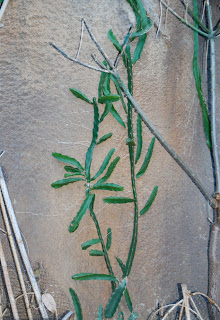 Averrhoa Carambola
Averrhoa CarambolaSynonyms : Carambole (French), Carambola (Spanish), Ma Fueng (Thaïland), Fuang (Laos), Khe (Vietnam), Belimbing (Malaysia)
 Flowers appear in groups at the pit between the leaves and the stem or at the branch apex. They are of pink colour. The blooming begins between November and December and the flowers follow one another until May.
Flowers appear in groups at the pit between the leaves and the stem or at the branch apex. They are of pink colour. The blooming begins between November and December and the flowers follow one another until May.

 The fruit is composed of 5 to 6 salient fins. The star shaped cross section gives to the Carambola its common name of Star fruit as well as it colour : translucent yellow.
The fruit is composed of 5 to 6 salient fins. The star shaped cross section gives to the Carambola its common name of Star fruit as well as it colour : translucent yellow. The Carambolas need to be planted at least 20 feet far away from each other. You have to fertilize the plants four to five times a year and to give regular and moderate amount of water throughout the year. The fruiting period is situated during the months of June, July and August but in some regions of the world, you can have a n all year fruitung period. The first fruits appear at 4 to 5 years of age.
The Carambolas need to be planted at least 20 feet far away from each other. You have to fertilize the plants four to five times a year and to give regular and moderate amount of water throughout the year. The fruiting period is situated during the months of June, July and August but in some regions of the world, you can have a n all year fruitung period. The first fruits appear at 4 to 5 years of age. Uses : Fruits are generally eaten raw, but occasionally they can be used in desserts or juices. The best way to consume a Carambola, it is when it is ripe. The fruit is entirely an edible fruit, incluiding the skin.
Uses : Fruits are generally eaten raw, but occasionally they can be used in desserts or juices. The best way to consume a Carambola, it is when it is ripe. The fruit is entirely an edible fruit, incluiding the skin. 


 Description : The mangosteen tree is growing slowly, reaching from 20 to 80 feet in height with a pyramidal crown. The evergreen, elliptic and opposite leaves present two colours: the upper side of the leaf is green and bright; while the lower side is yellow-green and matted.
Description : The mangosteen tree is growing slowly, reaching from 20 to 80 feet in height with a pyramidal crown. The evergreen, elliptic and opposite leaves present two colours: the upper side of the leaf is green and bright; while the lower side is yellow-green and matted. 
.jpg) The fruit is round but lightly flattened at both ends. Mangosteen fruit is surrounded by a thick and smooth rind. When the fruit is ripe, the rind passes from yellow-green to red-purple. It contains from 6 to 8 white fruit segments: arils of the seeds.
The fruit is round but lightly flattened at both ends. Mangosteen fruit is surrounded by a thick and smooth rind. When the fruit is ripe, the rind passes from yellow-green to red-purple. It contains from 6 to 8 white fruit segments: arils of the seeds.



 Description : Physalis is a perennial plant reaching from 1 to 2 feet in height: it is usually small, like tomato plant. The plant has green hairy leaves. The yellow flower is hermaphrodite. The fruit is a small round berry about the size of a marble with a lot of small yellow seeds in it. The colour of the ripe fruit is yellow or orange. The fruit is surrounded by a calyx: a kind of pod which looks like a lantern.
Description : Physalis is a perennial plant reaching from 1 to 2 feet in height: it is usually small, like tomato plant. The plant has green hairy leaves. The yellow flower is hermaphrodite. The fruit is a small round berry about the size of a marble with a lot of small yellow seeds in it. The colour of the ripe fruit is yellow or orange. The fruit is surrounded by a calyx: a kind of pod which looks like a lantern.

.bmp)






